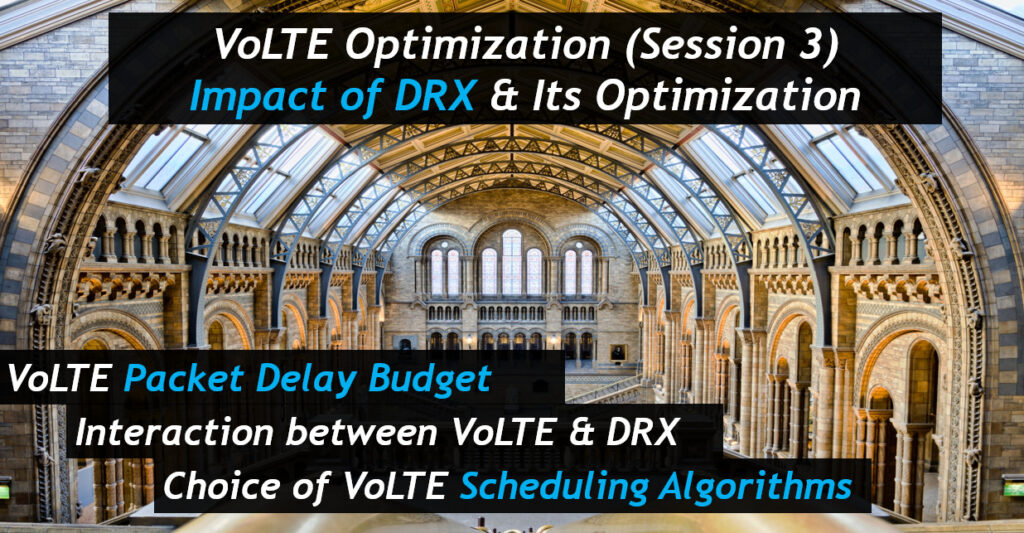This video “VoLTE Optimization (Session 3) – Impact of DRX & Optimization Actions” explains the significance of DRX for VoLTE and also various possible configurations of DRX that can be used with VoLTE along with their Pros and Cons. However, the DRX has an impact on VoLTE Call Quality due to the strict QCI-1 Packet Delay Budget. Consequently, we need to take actions to mitigate this impact.
Multiple options are explained including simple Packet Delay Budget Extension, Tricks to reduce DRX usage along with various scheduling algorithms.
VoLTE Optimization (Session 3) – Impact of DRX & Optimization Actions
A VoLTE packet usually has a Packet Delay Budget of 100ms. This means that if the packet is delayed more than 100ms, it will be discarded.
If there is no DRX, then a packet comes in the eNB buffer and it can be transmitted any time to the UE. If the first or second transmission are not successful, there are still many opportunities to re-transmit the packet.
Now, consider a scenario, where we have DRX cycle of 20ms. In this case, there are 5 scheduling opportunities for the UE to be scheduled. This is still good and it has a high probability that the UE will get the packet within 100ms.
However, if we look at the 40ms cycle, then the UE has 2 or 3 scheduling opportunities to receive the packet within 100ms. This makes it very important that the first transmission is successful otherwise the packet might be lost. Also, since the cycle is 40ms and the VoLTE packet is generated every 20ms, so this means that there will be 2 packets bundled in each 40ms scheduling interval.
This means that PDCCH reliability is extremely important for VoLTE Call Quality.
As per 3GPP 23.203, the Packet Delay Budget for VoLTE QCI1 is supposed to be 100ms. This means that any packet delayed more than 100ms should be discarded. However, slight increase can be done on the PDB but it should not be excessively increased as it can cause to produce lag or delay in the end user experience.
As most of the packet discards can happen due to retransmissions (especially PDCCH DTX) so it should mostly be related to UEs that are in poor radio coverage.
Therefore, a simple trick to reduce impact of DRX on poor radio condition UEs is to increase the TTI Bundling threshold as the TTI Bundling activation results in DRX deactivation.
Various Scheduling algorithms are present. In Round Robin scheduling each UE will get equal share of the resources which is good overall but will still cause packet discards due to strict VoLTE Packet Delay Budget. Similarly, the Max C/I scheduler will give more resources to UEs in good radio conditions which will starve the UEs in poor radio conditions resulting in higher packet discard rate. However, the best scheduling algorithm for VoLTE would be Delay-Based Scheduling as that would be able to counter the strict Packet Delay Budget of VoLTE.
In case you have any queries or want to connect with Ali Khalid, please feel free to drop a comment or follow him on LinkedIn. Also, if this has been helpful, then please subscribe to our Youtube channel – Our Technology Planet for more exciting stuff and videos.
Ali Khalid
Latest posts by Ali Khalid (see all)
- 5G SA Cell Search & Network Entry Matrix - July 18, 2023
- Top 5G Interview Question – 5G RACH Process - July 10, 2023
- 5G RSRP RSRQ SINR Conversion Mapping - June 30, 2023

Hello,
it’s a nice article and very well explained.
However, I have have few doubts .
what are factors to consider to set value of on duration timer ,short drx cycle and long drive cycle. as I have seen that Apple Hs is getting an issue with default drive settings where as there is no issue in Android hs. so can you put more light on this
Thanks for your comment, Atit. Can you please post your question under this video on YouTube (URL below) and Ali Khalid will be able to reply then 🙂
https://youtu.be/x4OKyi6O3FY